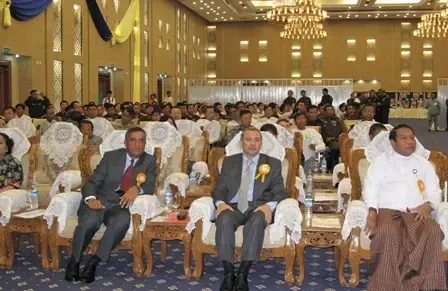100 maps that bring differences and similarities of people in Myanmar to life
The first Census Atlas of Myanmar uncovers the different realities for people in Myanmar. The maps visualize significant geographical diversity when it comes to school attendance, literacy, employment opportunities, housing, household amenities and other socio-economic indicators.
For example, the maps show that Chin State has the highest school attendance rate at 81.1 per cent while Shan State has the lowest at 56.6 per cent. The maps show that child labour is proportionally low in areas with high school attendance.
While these findings have been clear since census results were first published in 2015, the maps in the Census Atlas bring the data to life. The visuals highlight socio-demographic differences and similarities of people in Myanmar from a geographical perspective.
The Census Atlas is intended to serve as a guide to policymakers and local authorities and communities that work to improve the living conditions of people in Myanmar.
The Census Atlas gives important insight into Sustainable Development Goal indicators, including health, education, sanitation, and electricity. The visualization in maps reveals significant, and sometimes surprising, differences between states/regions, districts, and even townships.
| WHAT: | Launch event for the first Census Atlas of Myanmar |
| WHEN: | 9.30-12.00, Thursday 23 November, 2017 |
| WHERE: | Hotel Max, Nay Pyi Taw |
| WHO: | U Myint Kyaing, Permanent Secretary, Department of Population Ms Janet Jackson, UNFPA Representative for Myanmar |
For more information or media inquiries please contact:
Yenny Gamming; Tel: +95- (0)9 2604 00005; gamming@unfpa.org;
Si Thu Soe Moe; Tel: +95 (0)9 4500 57730; soemoe@unfpa.org
Notes to Editors
The census project
The main results of the 2014 Myanmar Population and Housing Census were published in May 2015. This report is part of a series of thematic reports on diverse topics. The thematic reports contain new data as well as previously released data which have been statistically adjusted for higher accuracy. The reports analyse the relationship between different data, and shed light on what the numbers tell us about the lives of people in Myanmar. The census was conducted by the Government of Myanmar. UNFPA has provided, and continues to provide, technical and financial support towards the census.
Non-enumeration
An estimated 1,090,000 people who wished to self-identify as Rohingya were not enumerated in the census. UNFPA recognizes their non-enumeration as a serious shortcoming of the census and a grave human rights concern, and regards it as critical that all rights are restored as soon as possible. An estimated 69,700 people in Kayin State and 46,600 people in Kachin State were also not enumerated. In total, an estimated 1.2 million people were not enumerated in the census. These estimated 1.2 million people were included in the total population count of 51.5 million. However, since data on characteristics is not available for the people who were not enumerated, the data and analysis presented in this report covers only those enumerated during the census.
Online census library
Census reports can be accessed at UNFPA’s website or at the Department of Population’s website.



